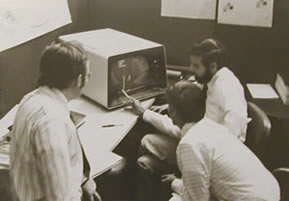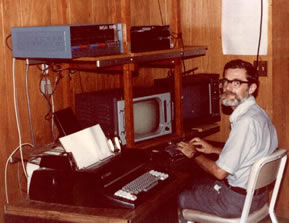 |
| DISSS Home | Contact Us |
|
||||||||
|
||||||||
|
|
| |||||||||||||||||||||||||||||||||||||||||||||||||||||||||||||||
|
|||||||||||||||||||||||||||||||||||||||||||||||||

1976 The beginning of flexible computing in public health. Auditorium A at CDC, converted to a war room for the Swine Flu crisis, is filled with epidemiologists and a Digital Equipment PDP 11 minicomputer the size of a refrigerator. A program called SOCRATES, written in FORTRAN by programmer Rick Curtis, allowed an epidemiologist to define questions, enter data, and summarize the results in tabular form without the aid of a programmer.
1978-84 The Epidemiologic Analysis System (EAS), a more flexible version of SOCRATES, was written in BASIC by Anthony (Tony) Burton of CDC and set up on a minicomputer for remote access by the Georgia state health department.
1978-84 The Conference (now Council) of State and Territorial Epidemiologists formed a Computer Working Group, and, together with Drs. Keewhan Choi and Stephen Thacker of CDC, developed a five-point plan for development of epidemiologic computing.
1984 Dr. Andrew Dean, Chairman of the CSTE Computer Working Group, served as President of CSTE and then was invited by Dr. Howard Ory to come to CDC and develop software for epidemiologists. He produced plans for a series of programs called EPI-AID to assist epidemiologists in outbreak investigations.
Dr. Andy Dean, State Epidemiologist of Minnesota, became frustrated with the lack of flexibility of computer resources in the mid-1970s and vowed to join the microcomputer revolution.

Although, as Director of Disease Prevention and Control,
he was unable to commit daytime hours to the effort, he built and programmed
an IMSAI computer in the evening. After several years, the project
began to approach the useful stage. At about the same time, he
was invited to come to CDC and produce software for epidemiologists.
 |
1985 Jeffrey A. Dean, a Junior at Paidea High School, began a field internship in computing at an insurance company, which required keeping a large printer supplied with paper. He expressed a desire for a more challenging experience to his Dad, who gave him specifications for a data entry program for epidemiology. During March 1985, he wrote ENTER in Turbo Pascal, the language he had previously used to adapt a mainframe version of Dungeons and Dragons to a microcomputer. |
 |
Tony Burton, author of the BASIC version of the Epidemiologic Analysis System, provided ideas for the first version of ANALYSIS, programmed by Jeff during the summer of 1986. Several years later, Tony moved to the Global Programme on AIDS, World Health Organization, Geneva, and he and Jeff continued to collaborate on later versions of Epi Info™ as Jeff traveled to Geneva during college vacations. |
 |
Dr. Richard Dicker, author of the Epidemiology in Action training manual and coordinator of the Epidemic Intelligence Service (EIS) course at CDC, provided advice on the statistics that were included with Epi Info™. |
Privacy Policy | Accessibility CDC Home | Search | Health Topics A-Z This page last updated June 16, 2008 United States
Department of Health and Human Services "Epi Info" is a trademark of the Centers for Disease Control and Prevention (CDC) |